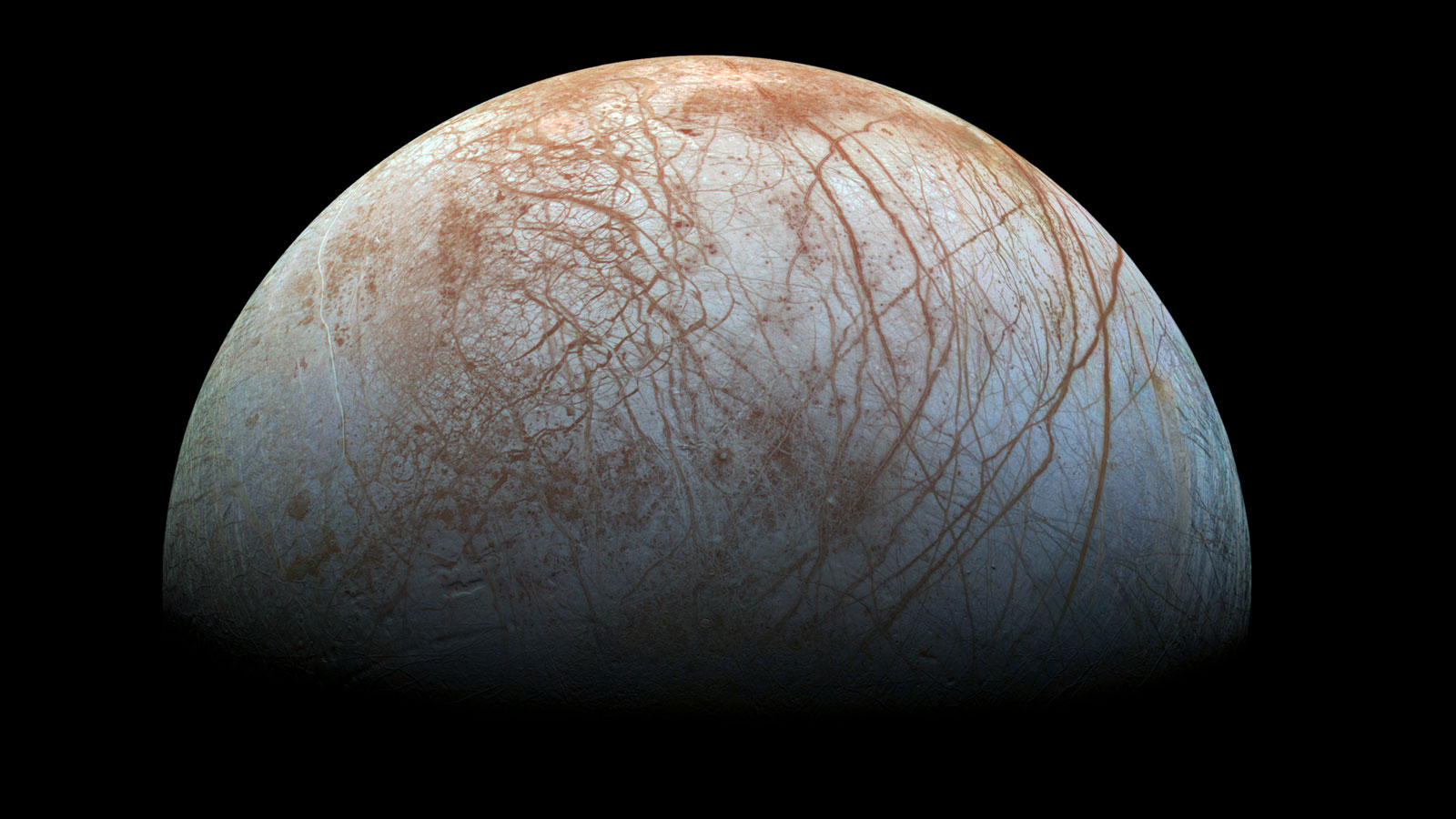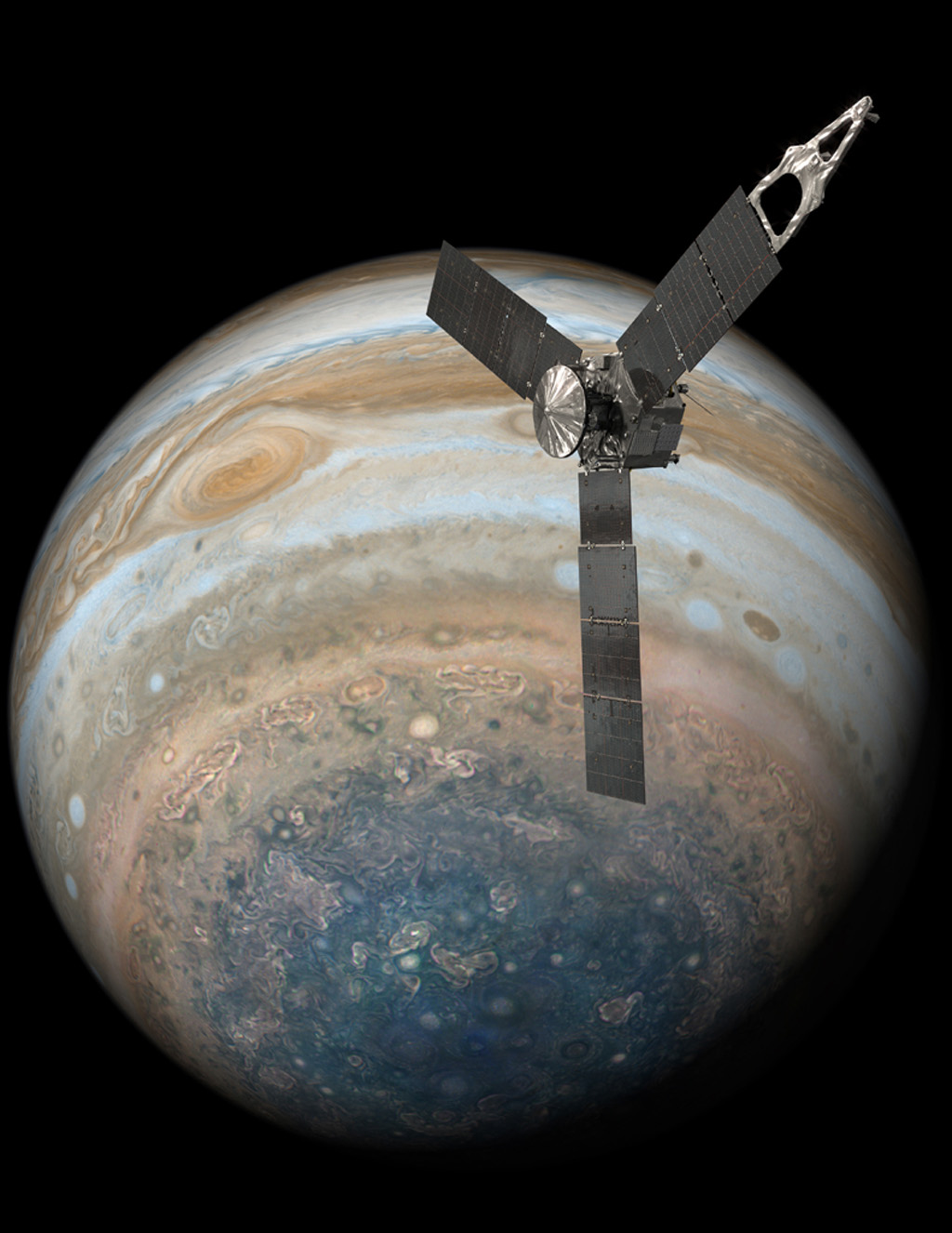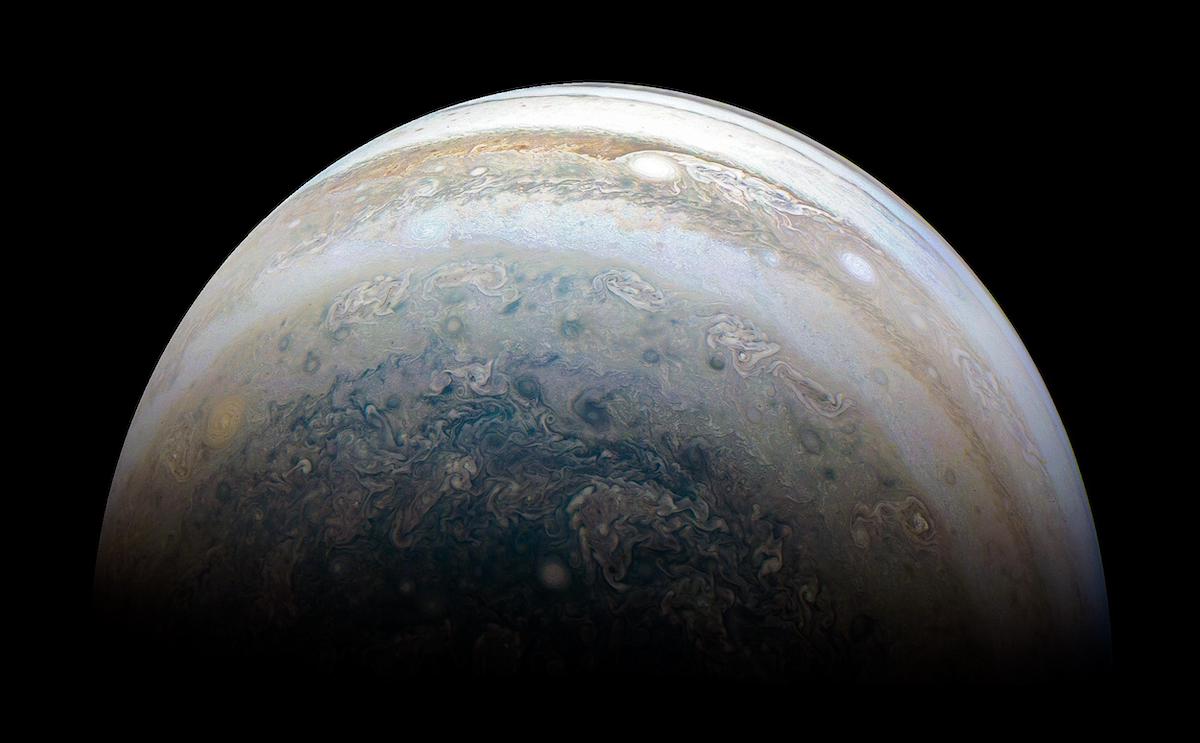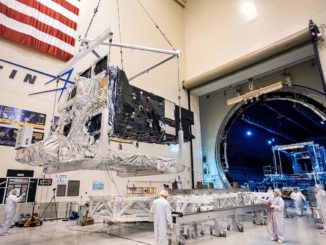
NASA’s Juno spacecraft could perform the first close flybys since the early 2000s of three of Jupiter’s largest moons, including Europa, if the space agency grants the mission an extension, Juno’s lead scientist said recently.
Since entering orbit around Jupiter in July 2016, the Juno spacecraft’s suite of science instruments has probed the giant planet’s atmosphere and internal structure, revealing new insights about Jupiter’s cyclonic storms and detecting evidence for a large, potentially dissolved core at its center.
“We went out to discover a core, whether there was a compact core inside Jupiter or not,” said Scott Bolton, Juno’s principal investigator at the Southwest Research Institute. “We were surprised because it is a large, dilute core.”
Juno’s five-year primary mission phase ends in July 2021, and mission managers have proposed an extension that would continue operations until September 2025. The spacecraft’s additional orbits around Jupiter will bring Juno closer to the planet’s moons, allowing for a more diversified set of scientific targets.
“One of the exciting things about the mission (extension) is we’re going to go and visit the satellites and the rings,” Bolton said last month in a meeting of NASA’s Outer Planets Advisory Group. “It really becomes a full system explorer, not as focused as the prime mission was, so it feeds potentially a more diverse (scientific) community because the satellite geologists, the ring people will all get data that I think is very interesting and unique.”
The solar-powered Juno spacecraft launched in August 2011, beginning a five-year cruise to Jupiter. Juno became the second spacecraft to orbit Jupiter when it arrived July 4, 2016.
Juno’s nine scientific instruments include a microwave radiometer for atmospheric soundings, ultraviolet and infrared spectrometers, particle detectors, a magnetometer, and a radio and plasma waves experiment. The Jupiter orbiter also carries a color camera known as JunoCam, which collects image data for processing and analysis by an army of citizen scientists around the world.
Juno’s science team last month submitted a proposal to NASA for an extended mission that would continue spacecraft operations four more years until 2025. Bolton said the extended mission would allow Juno to tackle additional scientific goals.
“We have multiple flybys of Io, Europa and Ganymede,” Bolton said.

NASA officials are expected to decide by the end of the year whether to grant funding for the Juno team’s extended mission proposal. It is part of a regular process called a senior review, in which independent scientists rank the merits of continuing to operate NASA’s robotic science missions beyond their original planned lifetimes.
When considering the senior review recommendations, NASA balances the scientific productivity of older missions with priorities to develop and launch new spacecraft.
The flybys of Jupiter’s moons will be enabled by Juno’s changing orbit. Jupiter’s asymmetric gravity field is gradually perturbing Juno’s trajectory and pulling the closest point of the spacecraft’s elliptical, or egg-shaped, orbit northward over time, according to Bolton.
The northward migration of Juno’s perijove, or closest approach to Jupiter, will allow the spacecraft to get a closer look at the planet’s north pole. Juno was the first mission to glimpse Jupiter’s poles, and now the spacecraft could see the north pole and its cyclonic storms in greater detail.
“This gives us close proximity to the northern parts of Jupiter, which is a new frontier,” Bolton said. “We’ve seen a lot of activity there, so we’ll be able to explore it very close up, whereas in the primary mission we were limited to the lower latitudes.”
In an extended mission, the spacecraft will also be able to quantify how much water is bound up within Jupiter’s atmosphere, Bolton said.
Juno has been flying in a 53-day elliptical orbit since arriving at Jupiter more than four years ago. At the conclusion of its prime mission next year, the spacecraft will have completed 34 laps around Jupiter.
Built by Lockheed Martin, the spacecraft was originally supposed to maneuver into a tighter 14-day orbit in late 2016, but mission managers elected not to perform the rocket burn due to a problem with Juno’s main engine.
That decision meant Juno needed more time to gather the mission’s required science data. The spacecraft’s instruments collect most of their data while passing close to planet once every 53 days, not the 14-day cadence originally planned.
Scientists planned to have Juno complete 32 of the 14-day science orbits through February 2018, when its prime mission was scheduled to be over. At that time, ground controllers planned to intentionally crash the spacecraft into Jupiter’s atmosphere, avoiding the possibility of contaminating one of Jupiter’s potentially habitable moons.
The 53-day orbit meant Juno operated at a slower scientific cadence, but the longer orbit is what allows the mission to venture near Jupiter’s moons in the 2020s, Bolton said. Another benefit of the longer orbit was that Juno has been exposed to less severe radiation around Jupiter, allowing the $1.1 billion mission to operate longer than originally planned.
“It’s a saving grace,” Bolton said. “I think the lesson is that we were flexible, and that is good in missions. So when you’re designing a mission, try to be flexible because you don’t know what curveball you’re going to get thrown.”

Juno’s naturally evolving orbit is also what will permit the spacecraft to pass near Jupiter’s moons and rings.
The moon flybys would begin in mid-2021 with an encounter with Ganymede, Jupiter’s largest moon, at a distance of roughly 600 miles (1,000 kilometers), according to Bolton.
After a series of distant passes, Juno would swoop just 200 miles (320 kilometers) above Europa in late 2022 for a high-speed flyby. Only NASA’s Galileo spacecraft, which ended its mission in 2003, has come closer to Europa.
There are two encounters with Jupiter’s volcanic moon Io planned in 2024 at distances of about 900 miles (1,500 kilometers), according to the flight plan presented by Bolton last month.
Assuming NASA approves the mission extension, Juno will be able to look for changes on the surfaces of Jupiter’s moons since they were last seen up close by NASA’s Voyager and Galileo probes.
At Ganymede, Juno could map the moon’s surface composition and investigate the 3D structure of Ganymede’s magnetosphere. Ganymede is the only moon in the solar system known to have its own magnetic field.
Juno’s microwave radiometer would be able to probe the thickness of Europa’s global ice shell, which covers an ocean of liquid water. “We’ll see where the ice is thin and where it’s thick,” Bolton said.
The visit to Europa would give scientists a taste of what’s to come with NASA’s Europa Clipper mission, which could launch as soon as 2024. Europa Clipper will carry a more powerful radar — among other instruments — to measure the moon’s ice shell through a series of targeted flybys.
Juno’s spectrometers would also map concentrations of water ice, carbon dioxide and organic molecules across 40 percent of Europa’s surface, Bolton said.
The JunoCam imager would be able take pictures of Europa with a surface resolution 0.6 to 1.2 miles (1 to 2 kilometers), well short of the detail visible in the Galileo spacecraft’s Europa maps. But JunoCam would return the sharpest views of Europa in more than 20 years.
Imagery from JunoCam and Juno’s star tracker cameras would search for evidence of plumes erupting from Europa’s surface. The spacecraft’s other instruments would be tuned to look for particles lofted from Europa in the possible plumes. Signs of recurring eruptions from Europa were detected by the Hubble Space Telescope.
During its flybys with Io, Juno could look for evidence of a global magma ocean feeding Io’s volcanoes. Juno would also be able to observe active volcanoes in Io’s polar regions.
Juno would also take pictures of Jupiter’s tenuous rings during a potential extended mission. The spacecraft’s dust detector might also register impacts from ring particles, Bolton said.
‘We’re really going to be able to look at the rings in a much better way with remote sensing, as well as the in situ instruments,” Bolton said.
Email the author.
Follow Stephen Clark on Twitter: @StephenClark1.



